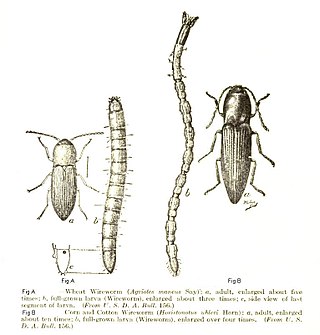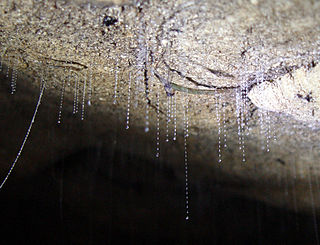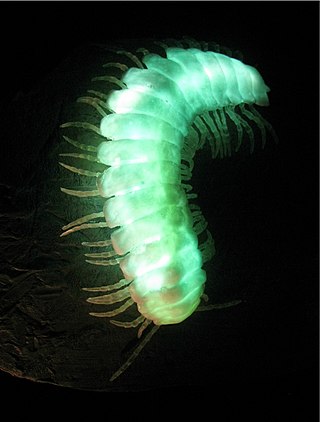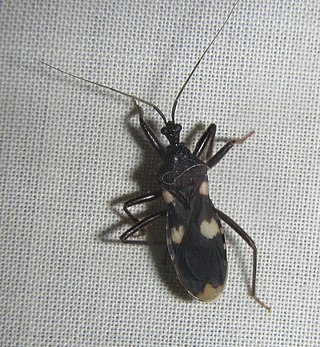
The aardwolf is an insectivorous species of hyena, native to East and Southern Africa. Its name means "earth-wolf" in Afrikaans and Dutch. It is also called the maanhaar-jackal, termite-eating hyena and civet hyena, based on its habit of secreting substances from its anal gland, a characteristic shared with the African civet.

Termites are a group of detritophagous eusocial insects which consume a wide variety of decaying plant material, generally in the form of wood, leaf litter, and soil humus. They are easily identified by the typically soft-bodied and unpigmented worker caste for which they have been colloquially termed "white ants"; however, they are not ants to which they are distantly related. About 2,972 extant species are currently described, 2,105 of which are members of the family Termitidae.

The Lampyridae are a family of elateroid beetles with more than 2,000 described species, many of which are light-emitting. They are soft-bodied beetles commonly called fireflies, lightning bugs, or glowworms for their conspicuous production of light, mainly during twilight, to attract mates. Light production in the Lampyridae is thought to have originated as an honest warning signal that the larvae were distasteful; this was co-opted in evolution as a mating signal in the adults. In a further development, female fireflies of the genus Photuris mimic the flash pattern of Photinus species to trap their males as prey.

Bioluminescence is the production and emission of light by living organisms. It is a form of chemiluminescence. Bioluminescence occurs widely in marine vertebrates and invertebrates, as well as in some fungi, microorganisms including some bioluminescent bacteria, and terrestrial arthropods such as fireflies. In some animals, the light is bacteriogenic, produced by symbiotic bacteria such as those from the genus Vibrio; in others, it is autogenic, produced by the animals themselves.

Bookworm is a general name for any insect that is said to bore through books.

Elateridae or click beetles are a family of beetles. Other names include elaters, snapping beetles, spring beetles or skipjacks. This family was defined by William Elford Leach (1790–1836) in 1815. They are a cosmopolitan beetle family characterized by the unusual click mechanism they possess. There are a few other families of Elateroidea in which a few members have the same mechanism, but most elaterid subfamilies can click. A spine on the prosternum can be snapped into a corresponding notch on the mesosternum, producing a violent "click" that can bounce the beetle into the air. Clicking is mainly used to avoid predation, although it is also useful when the beetle is on its back and needs to right itself. There are about 9300 known species worldwide, and 965 valid species in North America.

The beetle family Phengodidae is known also as glowworm beetles, whose larvae are known as glowworms. The females and larvae have bioluminescent organs. They occur throughout the New World from extreme southern Canada to Chile. The recently recognized members of the Phengodidae, the Cydistinae, are found in Western Asia. The family Rhagophthalmidae, an Old World group, used to be included in the Phengodidae.
Glowworm or glow-worm is the common name for various groups of insect larvae and adult larviform females that glow through bioluminescence. They include the European common glow-worm and other members of the Lampyridae, but bioluminescence also occurs in the families Elateridae, Phengodidae and Rhagophthalmidae among beetles; as well as members of the genera Arachnocampa, Keroplatus and Orfelia among keroplatid fungus gnats.

Histeridae is a family of beetles commonly known as clown beetles or hister beetles. This very diverse group of beetles contains 3,900 species found worldwide. They can be easily identified by their shortened elytra that leaves two of the seven tergites exposed, and their geniculate (elbowed) antennae with clubbed ends. These predatory feeders are most active at night and will fake death if they feel threatened. This family of beetles will occupy almost any kind of niche throughout the world. Hister beetles have proved useful during forensic investigations to help in time of death estimation. Also, certain species are used in the control of livestock pests that infest dung and to control houseflies. Because they are predacious and will even eat other hister beetles, they must be isolated when collected.

Blattodea is an order of insects that contains cockroaches and termites. Formerly, termites were considered a separate order, Isoptera, but genetic and molecular evidence suggests they evolved from within the cockroach lineage, cladistically making them cockroaches as well. The Blattodea and the mantis are now all considered part of the superorder Dictyoptera. Blattodea includes approximately 4,400 species of cockroach in almost 500 genera, and about 3,000 species of termite in around 300 genera.

Pyrophorus is a genus of click beetle. They are one of several genera in the tribe Pyrophorini, all of which are bioluminescent. Their bioluminescence is similar to that of another group of beetles, the fireflies, although click beetles do not flash, but remain constantly glowing. They have two luminescent spots at the posterior corners of the pronotum, and another brighter light organ on the most-anterior surface of the ventral abdomen. This light organ is even brighter and can only be seen when in flight. Bioluminescent click beetles are found throughout tropical, subtropical and temperate America. Species from Texas, Florida, Puerto Rico, and Cuba are now in different genera in the tribe Pyrophorini, such as Deilelater and Ignelater.

Arachnocampa luminosa, commonly known as New Zealand glowworm or simply glowworm, is a species of fungus gnat endemic to New Zealand. The larval stage and the imago produce a blue-green bioluminescence. The species is known to dwell in caves and on sheltered banks in native bush where humidity is high. Its Māori name is titiwai, meaning "projected over water".

The common dwarf mongoose is a mongoose species native to Angola, northern Namibia, KwaZulu-Natal in South Africa, Zambia and East Africa. It is part of the genus Helogale, along with the Ethiopian dwarf mongoose.

Lampyris noctiluca, the common glow-worm of Europe, is the type species of beetle in the genus Lampyris and the family Lampyridae.

Zopherus chilensis, also commonly known as the ma'kech or jewelled bug, is a species of ironclad beetle in the family Zopheridae. Despite the name "chilensis", nearly all of the known specimens have been found from Mexico to Venezuela.

Motyxia is a genus of cyanide-producing millipedes that are endemic to the southern Sierra Nevada, Tehachapi, and Santa Monica mountain ranges of California. Motyxias are blind and produce the poison cyanide, like all members of the Polydesmida. All species have the ability to glow brightly: some of the few known instances of bioluminescence in millipedes.

Pyrophorus noctilucus, common name headlight elater, is a species of click beetle.

Lucihormetica luckae is a species of giant cockroach (Blaberidae) from Ecuador.

Termitotrox cupido is a species of scarab beetle in the subfamily Termitotroginae. It was first described by Munetoshi Maruyama in 2012, having been discovered living inside a nest of the termite Hypotermes makhamensis in Cambodia. It is a tiny, blind and flightless insect.

Acanthaspis obscura is a species of assassin bug from tropical and subtropical Africa.


















